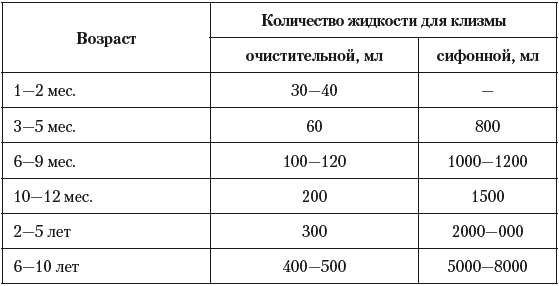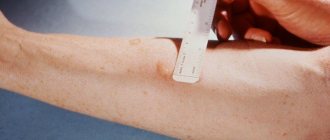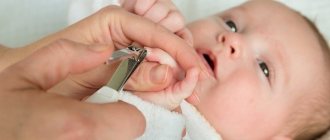What is an enema and what can it be?
What exactly is an enema? An enema is a medical procedure that involves injecting a liquid (water or medication) into the rectum.
I distinguish several types of enemas, depending on their purpose:
- Cleansing. Indicated for constipation, bloating, food poisoning, and for emptying the intestines of stool and gases. Performed using chilled boiled water.
It is very important that the water is exactly 24 - 26 ° C (room temperature). If you use hot water, you can cause a burn to the intestinal mucosa. Also, hot water dilates blood vessels and is well absorbed into the bloodstream, and the rectum is very well supplied with blood. Entering the bloodstream, water will pull with it all the toxins accumulated in the stool. “Fecal intoxication” may occur. The most terrible condition that can develop with this complication is cerebral edema.Therefore, before performing an enema, always consult a doctor, or even better, entrust the procedure to specialists.
- Laxative. Vaseline oil or glycerin is injected into the rectum with an enema. You can dilute them with a small amount of saline solution. This enema for an infant is indicated for constipation, especially when the baby has a dense consistency of stool. The oil solution softens the stool and helps the intestines empty.
- Hypertensive. The enema bulb is filled with a hypertonic solution (2.5%, 5% or 10%) of table salt.
This type of enema cleanses the intestines very well during prolonged constipation and is most often performed in a hospital setting by medical workers. The salty solution draws out the intestinal contents well. If you decide to prepare a hypertonic solution at home using water and salt, you must mix the solution thoroughly! Undissolved salt crystals can cause damage to your baby's intestinal lining. It is also necessary to observe the temperature regime of the solution. - Siphon. Such an enema is performed only in a hospital setting and is a purely medical procedure. A large volume of solution causes high intestinal lavage. Indicated for poisoning or fecal “blockages”.
- Medicinal enema. This is a method of administering a drug. Performed as prescribed by a doctor.
Types of enemas
There are many types of enemas to treat constipation. But not every one is suitable for a child. Since the baby’s body is easily injured, this moment should be taken seriously. During constipation, only 4 types of enemas help the baby:
- Cleansing. This procedure is not only intended to relieve constipation. It is a necessary measure before various medical procedures. To avoid unwanted absorption of liquid into the intestines, you need to do an enema using boiled water. However, it should be below body temperature.
- Siphon. This type of enema is prohibited for parents to perform at home. It can only be done by a specialist. The main indication for using this method of treatment is severe poisoning of the body.
- Medicinal. As a rule, it follows immediately after cleansing. It is done as a treatment for the inflammatory process in the intestines. The temperature of the water containing the diluted drug should not exceed 37 °C.
- Oily. Recommended for children under 3 months of age. The oil is heated to a temperature of 37 °C and slowly introduced into the intestines. It begins to act instantly, softening the stool. Enveloping them, it forms a special shell, which facilitates the easy release of accumulations from the intestines.
Each type of enema helps the baby get rid of constipation caused by various types of problems. Some of them can only be carried out by an experienced doctor to eliminate the possibility of injury to the child’s body. At home, parents can only do a cleansing enema. It is considered the safest.
What volume of cleansing enema does a child need?
In addition to the temperature regime, you need to know how much solution can be administered to the baby. When administering a cleansing enema, the amount of fluid administered directly depends on the age of the child. The younger the baby, the less solution is needed to empty the intestines. There are standards for the volumes permissible for performing an enema on a child.
| Up to two months | 30 ml |
| 2 – 4 months | 60 ml |
| 6 -9 months | 70 – 100 ml |
| 9 – 12 months | 120 – 170 ml |
| 1 – 2 years | 200 – 250 ml |
| 25 years | 300 ml |
| 6 – 10 years | 400 – 500 ml |
What is needed to perform a cleansing enema?
- First of all, you need to prepare the place for the procedure.
- On a flat surface (changing table or crib), you need to lay an oilcloth and put a clean diaper or sheet on top of it.
- To perform an enema for a child under 4-5 years old, use a syringe. A syringe is a pear-shaped rubber canister with a rubber or plastic tip. There are different volumes of “pears” - from 30 ml, for the smallest children, to 360 ml. You can buy a syringe at any pharmacy; its cost is on average 100 rubles. For children over 4 years old, an Esmarch mug is required to perform an enema. This is a rubber cylinder with a volume of 2 liters, from which comes a silicone tube with a removable plastic tip. The cost of such a system in pharmacies is 200 - 500 rubles.
- Before performing an enema, you should prepare an enema solution, petroleum jelly or baby cream. For children older than one year, it is necessary to prepare a potty in advance.
How to perform a cleansing enema on a baby?
- First of all, before giving an enema to a baby, you need to prepare everything you need so as not to be distracted during the procedure.
- Before performing an enema, you should wash your hands.
- The syringe is boiled for about 30 minutes. Then we wait until it cools down.
- We squeeze the can to release the air, then slowly unclench it and draw in the required amount of solution.
- The tip of the bulb is lubricated with Vaseline, vegetable oil or baby cream to reduce the risk of intestinal trauma.
- The baby lies on his back, his legs are pressed against each other and raised slightly upward. Children older than one year can be placed on their left side, pressing their knees to their stomach.
- We spread the buttocks with our fingers and carefully insert the tip into the rectum to a depth of 2 - 4 cm.
- Slowly squeezing the bulb, we introduce liquid into the intestine.
- Carefully remove the tip and squeeze the buttocks for a few minutes.
- After defecation, we wash the baby, and thoroughly wash and dry the syringe.
Instructions
Children are usually given an enema to cleanse their body and relieve constipation. To properly carry out this procedure at home, parents need to adhere to certain recommendations.
Liquid volumes
The optimal dosage of liquid can be determined based on the age of the baby.
- For a one-month-old baby, its volume should not exceed 25 milliliters.
- If the baby is 2–6 months old, he can be given 30–60 milliliters of water.
- From six months to a year, an enema with a volume of 120–130 milliliters will be optimal.
- After 1 year of life, a baby can be given an enema with a volume of 0.2 liters.
Until parents are completely sure that they have taken a normal dose of fluid for their baby, they cannot begin the enema procedure.

Preparatory actions
To ensure maximum comfort for the baby and reduce discomfort during the procedure, parents must follow a list of rules.
- Only a sterile rubber bulb should be used. Before first use, it must be boiled. During subsequent uses, the enema is washed with boiling water, which is poured inside. The rinsing procedure must be performed three times.
- Before placing the pear, you need to make sure that there is no boiling water inside it. If high-temperature water enters a child’s body, it will cause a burn. To avoid this, after sterilizing and emptying the enema, it must be postponed until the rubber reaches room temperature.
- The baby should be positioned correctly. He should lie on his back, and his legs should be pointed upward. Throughout the procedure, parents must hold the child's legs. Before the procedure, the baby should be placed in a diaper.
- The enema is filled with boiled water at a temperature not exceeding 28 degrees. The volume of water should be selected based on the age of the baby.
Introduction rules
To give an enema to a baby at home, you must follow the instructions.
- Before administering the enema, you need to press on it with your hand so that the air leaves its cavity.
- The child's anus is treated with Vaseline. You should also lubricate the tip of the bulb with a small amount of Vaseline.
- The end of the enema is slowly and carefully inserted into the baby's anus. The optimal insertion depth is 4 centimeters.
- Next, you need to slowly press the bulb so that all the water ends up in the baby’s intestines.
- After the enema is completely empty, it is carefully removed back.
- The child’s buttocks need to be squeezed with your hands so that the water does not leave his body prematurely. You need to keep the baby in this state for a minute.
Basically, after a properly administered enema, the baby will have a bowel movement within 5–10 minutes.

Consequences of an incorrect procedure
If you give an enema frequently, incorrectly or unreasonably, you can cause the following unpleasant consequences:
- washing out beneficial intestinal microflora that is not fully formed;
- development of inflammatory processes;
- activation of the absorption of toxic substances with the introduction of a large volume of water;
- suppression of the natural reflex to defecate;
- formation of intestinal fissures.
Performing a cleansing enema for children over 4 years of age
- To perform the procedure, we use Esmarch's mug.
- The solution is poured into a rubber container. The volume depends on the age of the child. We also make sure to observe the temperature regime.
- We release a small amount of the contents of the pear to displace the air from the tube.
- The balloon should be fixed 1 meter above the level of the lying child to ensure a downward flow of fluid.
- We connect the tip to the system, lubricate it with Vaseline or vegetable oil. Plastic tips can be disposable. Then we take it out of the sterile packaging and throw it away after the procedure. If the tip is reusable, it must be boiled before use.
- The child lies on his left side with his knees tucked to his stomach.
- The tip is carefully inserted into the rectum 2 cm towards the abdomen, and then 2 - 4 cm posteriorly, towards the tailbone.
- The clamp on the tube opens and the solution enters the intestines.
- The tip is removed, and the child must lie down for another 10 minutes until the unbearable desire to defecate.
- Then the child is seated on the potty or toilet to have a bowel movement.
If you experience frequent constipation, you should not abuse enemas. Consult a doctor to determine the causes of the disease and solve the problem. Frequent use of cleansing enemas can lead to addiction and disruption of natural bowel movements.
In addition to cleansing with liquid, an enema has an irritating effect that stimulates intestinal motility, which helps with bowel movements. But stool does not always come out after an enema. It is necessary to ensure that all the liquid introduced into the intestines comes out. Sometimes emptying does not occur immediately, but after 30 - 50 minutes.
A correctly performed procedure is harmless and alleviates the baby’s condition. If you are not confident in yourself, you should not undertake manipulation. Contact your pediatrician who will examine your child and help with performing an enema.
The need for an enema
After other nutrients begin to enter the child's body, in addition to breast milk, parents need to pay attention to the process of bowel movements of their baby. This need is due to the fact that the baby’s body may not accept new food, reacting with digestive failure.
If, after complementary feeding was first started, the baby has not pooped once in a day, he can be given an enema to avoid poisoning.
If constipation occurs repeatedly or its duration increases, you should seek help from a clinic, where, based on tests, the doctor will diagnose the cause of this pathological phenomenon.
Usually an enema is necessary in three situations
- To administer medication. This measure is taken to speed up the absorption of the medicine and its active effect on the child’s body.
- If the baby is poisoned, an enema is used to remove toxic substances that enter through the intestinal walls.
- An enema is used to empty the bowel during constipation, as it helps activate the functions of the intestinal tract.












